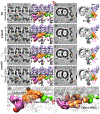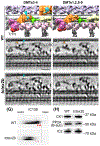Structural organization of the intermediate and light chain complex of Chlamydomonas ciliary I1 dynein
- PMID: 33993568
- PMCID: PMC8820979
- DOI: 10.1096/fj.202001857R
Structural organization of the intermediate and light chain complex of Chlamydomonas ciliary I1 dynein
Abstract
Axonemal I1 dynein (dynein f) is the largest inner dynein arm in cilia and a key regulator of ciliary beating. It consists of two dynein heavy chains, and an intermediate chain/light chain (ICLC) complex. However, the structural organization of the nine ICLC subunits remains largely unknown. Here, we used biochemical and genetic approaches, and cryo-electron tomography imaging in Chlamydomonas to dissect the molecular architecture of the I1 dynein ICLC complex. Using a strain expressing SNAP-tagged IC140, tomography revealed the location of the IC140 N-terminus at the proximal apex of the ICLC structure. Mass spectrometry of a tctex2b mutant showed that TCTEX2B dynein light chain is required for the stable assembly of TCTEX1 and inner dynein arm interacting proteins IC97 and FAP120. The structural defects observed in tctex2b located these 4 subunits in the center and bottom regions of the ICLC structure, which overlaps with the location of the IC138 regulatory subcomplex, which contains IC138, IC97, FAP120, and LC7b. These results reveal the three-dimensional organization of the native ICLC complex and indicate potential protein-protein interactions that are involved in the pathway by which I1 regulates ciliary motility.
Keywords: IC140; ICLC complex; TCTEX2B; cryo-electron tomography; flagella.
© 2021 Federation of American Societies for Experimental Biology.
Conflict of interest statement
CONFLICT OF INTEREST
The authors have declared no conflicts of interest for this article.
Figures





Similar articles
-
Chlamydomonas IC97, an intermediate chain of the flagellar dynein f/I1, is required for normal flagellar and cellular motility.mSphere. 2024 Dec 19;9(12):e0055824. doi: 10.1128/msphere.00558-24. Epub 2024 Nov 27. mSphere. 2024. PMID: 39601552 Free PMC article.
-
The ciliary inner dynein arm, I1 dynein, is assembled in the cytoplasm and transported by IFT before axonemal docking.Cytoskeleton (Hoboken). 2014 Oct;71(10):573-86. doi: 10.1002/cm.21192. Epub 2014 Oct 30. Cytoskeleton (Hoboken). 2014. PMID: 25252184 Free PMC article.
-
The IC138 and IC140 intermediate chains of the I1 axonemal dynein complex bind directly to tubulin.Biochim Biophys Acta. 2013 Dec;1833(12):3265-3271. doi: 10.1016/j.bbamcr.2013.09.011. Epub 2013 Sep 27. Biochim Biophys Acta. 2013. PMID: 24080090
-
Composition and function of ciliary inner-dynein-arm subunits studied in Chlamydomonas reinhardtii.Cytoskeleton (Hoboken). 2021 Mar;78(3):77-96. doi: 10.1002/cm.21662. Epub 2021 Apr 28. Cytoskeleton (Hoboken). 2021. PMID: 33876572 Free PMC article. Review.
-
Functional diversity of axonemal dyneins as studied in Chlamydomonas mutants.Int Rev Cytol. 2002;219:115-55. doi: 10.1016/s0074-7696(02)19012-7. Int Rev Cytol. 2002. PMID: 12211628 Review.
Cited by
-
TCTEX1D2 is essential for sperm flagellum formation in mice.Sci Rep. 2025 Jan 18;15(1):2413. doi: 10.1038/s41598-024-83424-1. Sci Rep. 2025. PMID: 39827215 Free PMC article.
-
Structure and Function of Dynein's Non-Catalytic Subunits.Cells. 2024 Feb 11;13(4):330. doi: 10.3390/cells13040330. Cells. 2024. PMID: 38391943 Free PMC article. Review.
-
Light chain 2 is a Tctex-type related axonemal dynein light chain that regulates directional ciliary motility in Trypanosoma brucei.PLoS Pathog. 2022 Sep 26;18(9):e1009984. doi: 10.1371/journal.ppat.1009984. eCollection 2022 Sep. PLoS Pathog. 2022. PMID: 36155669 Free PMC article.
-
Chlamydomonas IC97, an intermediate chain of the flagellar dynein f/I1, is required for normal flagellar and cellular motility.mSphere. 2024 Dec 19;9(12):e0055824. doi: 10.1128/msphere.00558-24. Epub 2024 Nov 27. mSphere. 2024. PMID: 39601552 Free PMC article.
-
Cryo-electron tomography of eel sperm flagella reveals a molecular "minimum system" for motile cilia.Mol Biol Cell. 2025 Feb 1;36(2):ar15. doi: 10.1091/mbc.E24-08-0351. Epub 2024 Dec 11. Mol Biol Cell. 2025. PMID: 39661459 Free PMC article.
References
Publication types
MeSH terms
Substances
Grants and funding
LinkOut - more resources
Full Text Sources
Other Literature Sources
Miscellaneous

